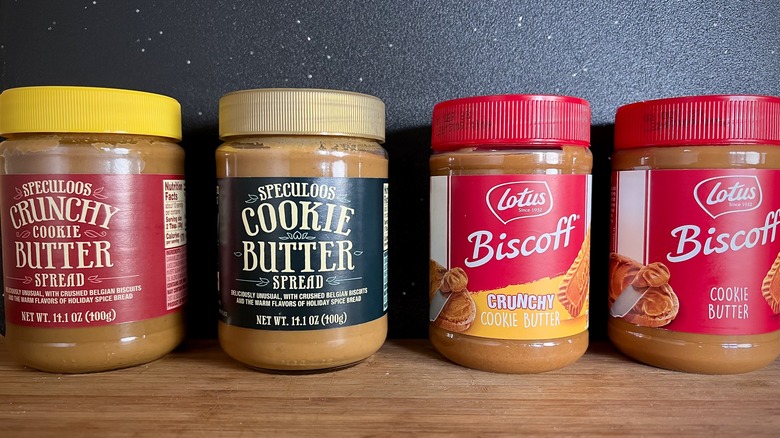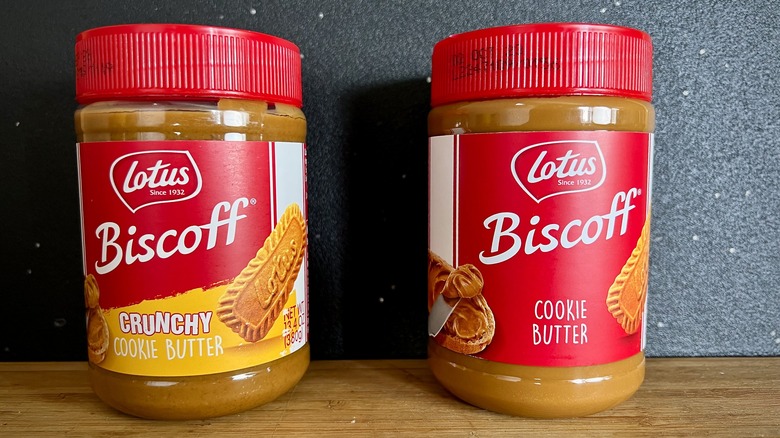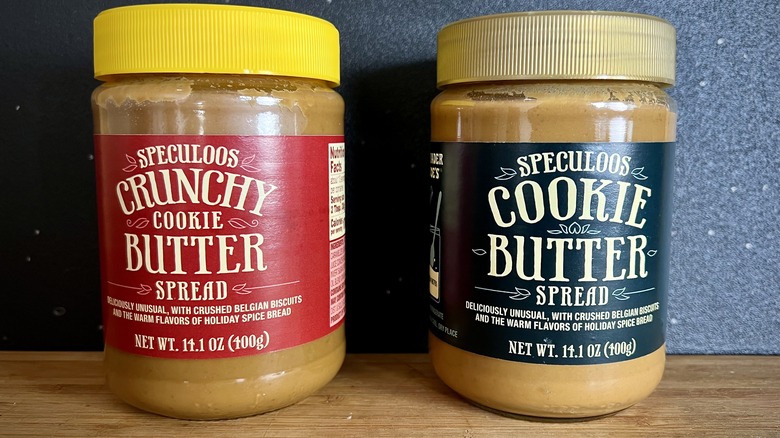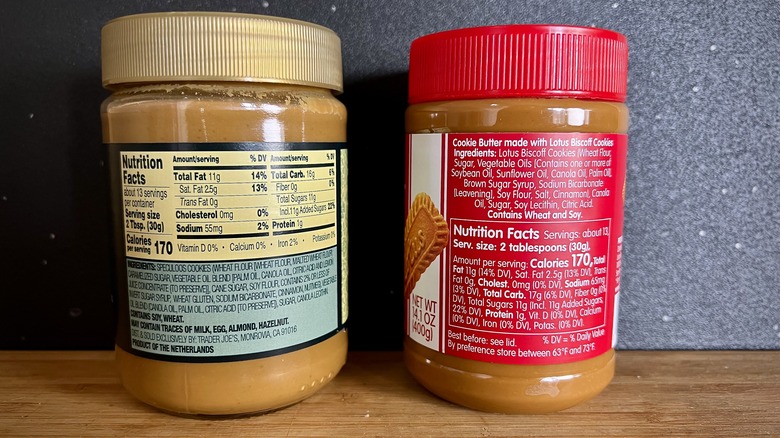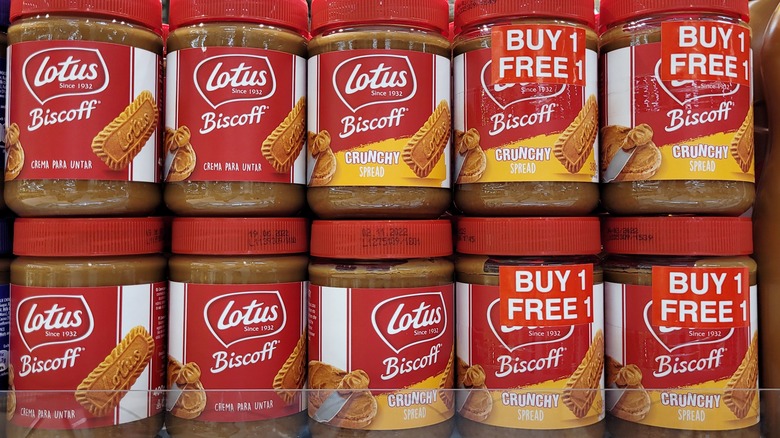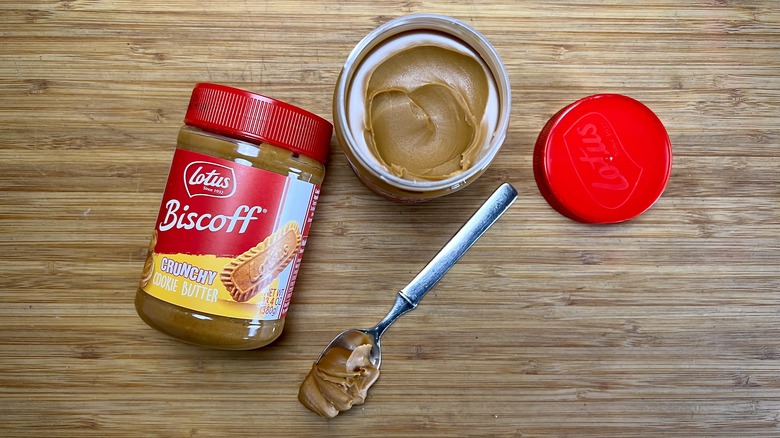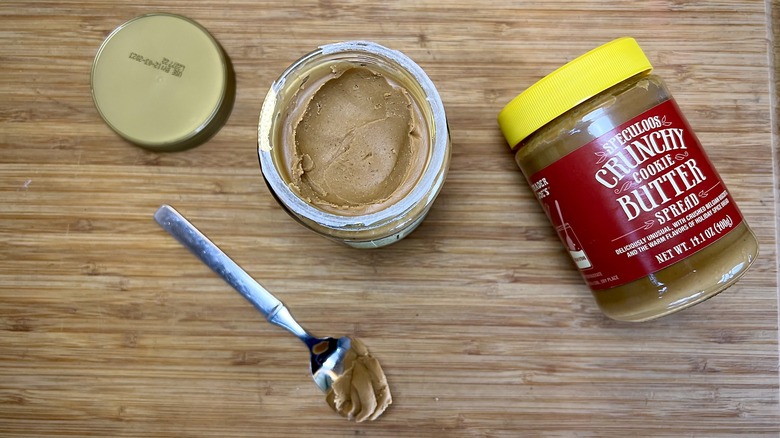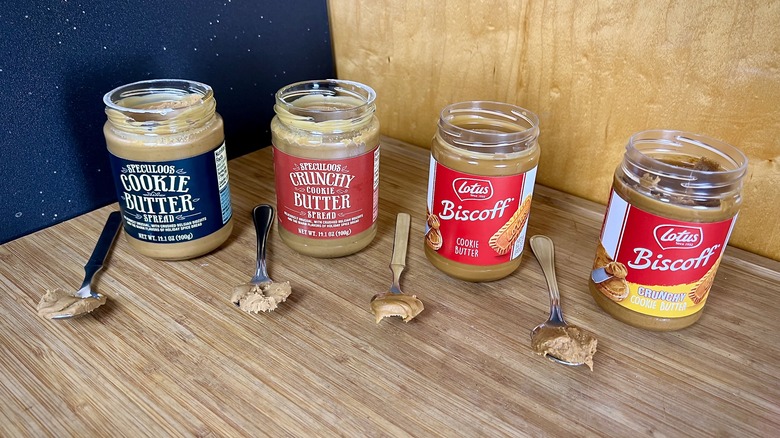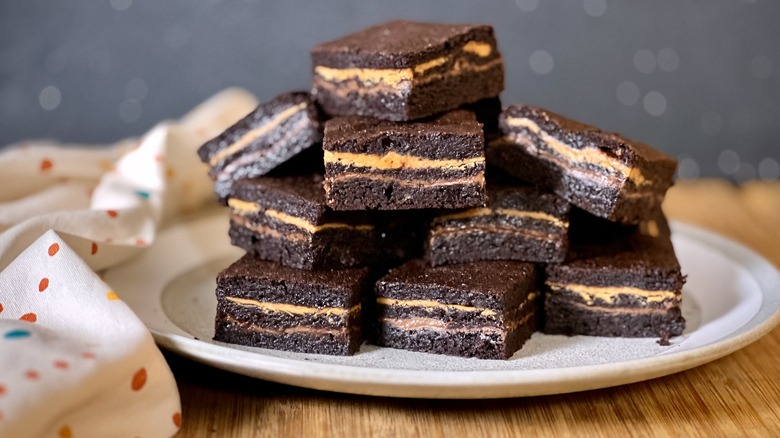Trader Joe's Speculoos Vs. Lotus Biscoff: The Battle For The Better Cookie Butter
If you live in the United States, you may think of Lotus Biscoff cookies as a mid-flight snack, thanks to Delta Airlines. The airline started serving these cinnamon-sugar, caramelized-flavored biscuits in the 1980s, but they've been around for centuries in Belgium, France, and the Netherlands. Known as speculoos cookies (named after the Latin word for "spice"), these biscuits were traditionally served around Christmas time. However, enterprising cookie fans started packing the crumbs inside two pieces of bread to turn the cookies into a paste, eventually becoming the spreadable version we know today: cookie butter.
Once you open the jar, the contents might look like peanut butter, but a single bite reveals it is nothing like its nutty counterpart. It's warming, buttery, and rich, and something about it unlocks the childhood memories of eating gingerbread. It's as sweet as Nutella but has the texture of nut butter, and it's remarkably addictive.
While Lotus produced the original cookie butter, Trader Joe's version might be the most recognizable speculoos spread stateside. The jars have garnered something of a cult following and the popular retailer even sells a quart of ice cream laced with its cookie butter. We wondered whether Lotus the originator or hot shot Trader Joe's produced the better cookie butter, so we picked up a few jars (both brands offer creamy and crunchy options) and put them to the test. After comparing texture, flavor, mouthfeel, and spreadability, one walked away a clear winner. But let's be real here: There were no losers in the group.
How Lotus Biscoff Cookie Butter came to be
Lotus brand produced the original jars of cookie butter, and it's probably the most well-known maker of speculoos cookies in the United States, too. This Belgian company started baking cookies in 1932, marketing its product as a perfect companion for coffee. The caramelized flavors in the sweet shortbread were an ideal match for the roasted flavors in coffee, and the cookie took off. Later, it named the product Biscoff by combining the words "biscuit" and "coffee."
It wasn't until 2008 that the cookies were turned into the delicious, buttery spread we know and love today. One popular use for Speculoos cookies was to turn them into a sandwich, slathering the bread with butter and topping it with cookie crumbs. After a few hours, the crunchy cookies transformed into a soft paste. A woman submitted the idea of making a spreadable form of Biscoff to the TV show "De Bedenkers" ("The Inventors"). Lotus approached the woman after the show aired and they worked together to develop speculoospasta (aka, cookie butter). The product was an immediate hit, bringing in 10 million euros in 2009.
Why you might want to opt for Trader Joe's version
Lotus once held the Belgian patent for cookie butter, preventing any competitors from producing this sweet, spiced spread. A judge later nullified the patent, as there was evidence that the recipe had been floating around on online blogs for years before Lotus Biscoff Cookie Butter launched its recipe. That meant a free market for companies like Trader Joe's to proceed with their own version.
Trader Joe's Speculoos Cookie Butter Spread was enormously successful and launched to the top of the store's "most popular products" list in 2012 (and it continued to win the number one spot on that list through 2015 before Mandarin Orange Chicken finally dethroned it in 2016). Customers couldn't get enough of the product, leading to eventual shortages that only fueled Trader Joe's fanatics to want more of that cookie butter goodness. It's hard to say what made people love the product so much: the flavor, the texture, or the fact that the cost of Trader Joe's Cookie Butter has remained close to its initial relatively inexpensive price tag of $3.69 since it launched in 2011. Whatever it was, Trader Joe's Cookie Butter certainly has a following of dedicated fans. In fact, we happen to think that it deserves to be in the Trader Joe's hall of fame.
Does the nutritional content differ between the two?
The nutritional contents between Lotus Biscoff and Trader Joe's Speculoos Cookie Butter Spread are remarkably similar. Both jars weigh 14.1 ounces (or 400 grams) and have a serving size of 2 tablespoons (or 30 grams). A lot of the nutrition facts are the same, too. Both creamy varieties contain 170 calories, 11 grams of fat, 11 grams of added sugars, and 1 gram of protein. The Trader Joe's Speculoos Cookie Butter Spread has 55 milligrams of sodium and 16 grams of carbohydrates (although the crunchy version contains 17 grams of carbohydrates). The Lotus Biscoff Cookie Butter has 65 milligrams of sodium (and 70 milligrams for the crunchy variety) and 17 grams of carbohydrates (or 18 grams for crunchy).
The major difference between the two comes in the allergen disclosures. They both contain wheat and soy, but Trader Joe's disclaims that the product may contain traces of milk, egg, almond, and hazelnut. Lotus not only specifically states that the contents are nut-free, but it also says the product is vegan-friendly, contains no artificial colors or flavors, and that the ingredients are free of GMOs.
Which cookie butter is more expensive?
Both Lotus and Trader Joe's provide a 14.1-ounce jar of shelf-stable spread, but Trader Joe's glass jars are only $3.99, or $0.30 per two-tablespoon serving. At our local Fred Meyer grocery store, the Lotus brand was $6.49, or $0.50 for the same serving size. After a little searching online, we were able to find bulk orders for as low as $4.73 per jar for Lotus, but it's hard to say if that deal is always available.
The prices were the same across the brands for the crunchy or creamy varieties, which is good news if your family consists of both fans of the smooth, creamy cookie butter and the crunchy, sugar-flecked variety. However, your choice of venue vastly determines the price of the cookie butter you take home.
If you really want to save money, you can always try your hand at making cookie butter at home. A 3.28-ounce package of Biscoff cookies costs $2.49 and can be turned into a cup of cookie butter. Simply blend it with water, coconut oil, and a little corn syrup (you could also use brown sugar or honey if you prefer). You can save even more money by buying the cookies in bulk online or grabbing Biscoffs at your local Costco store if you're so lucky.
What does Lotus Biscoff Cookie Butter taste like?
We started our taste test with the smooth cookie butter before moving on to the crunchy version to find out if there was a noticeable difference between the two. The criteria for the taste test were the same for each version: assessing the product's texture, flavor, aroma, mouthfeel, and spreadability.
The aroma of both jars was identical, and we were greeted with the smell of brown sugar and molasses that reminded us of gingerbread. If we closed our eyes, we could imagine the cookies baking in the oven! The smooth Biscoff spread tasted exactly like a ground-up cookie, first with a pleasant sweetness spreading over our tongue before the warming spices of cinnamon took over. It was shiny and smooth, and it spread easily onto a piece of bread. It was also dangerously easy to eat by the spoonful.
The crunchy version had the same flavor, but it was less processed. It didn't contain big chunks of cookies, but it felt like little crystals of sugar exploded on our palate with every bite. There was nothing to hate about either version; they were pure bliss.
What does Trader Joe's Speculoos Cookie Butter Spread taste like?
Our approach to Trader Joe's Speculoos Cookie Butter Spread was the same that we took with the Lotus brand, tasting both the creamy and crunchy variety. The initial aroma here was less brown-sugar forward, but with prominent notes of cinnamon and nutmeg. It didn't necessarily remind us of cookies, but it smelled pleasant enough to want to dig in right away.
The smooth variety was very thick, sticking to our tongues as we chewed. That also made it a little harder to spread on soft bread, but not impossible. While we noticed warming spices on the nose, we found they weren't as noticeable on our taste buds. It mostly just tasted sugar-forward, and it reminded us more of sweet peanut butter than of speculoos cookies. It was also more textured than the smooth Lotus Biscoff, containing some speckled texture and grit.
While the Lotus's crunchy cookie butter tasted like a completely different product from the smooth, the Trader Joe's version tasted like it just mixed chunks of cookies into the creamy version. The base was the same slightly-textured cookie butter, but you would encounter a small piece of actual cookie from time to time.
The verdict: Which is the better cookie butter?
Both cookie butters were good, but there was a clear winner. All of our tasters agreed that the smooth and crunchy Lotus Biscoff Cookie Butter won across all categories (texture, flavor, aroma, mouthfeel, and spreadability). They were split about which they preferred — smooth or crunchy — similar to how people choose teams for peanut butter based on textural preferences.
Overall, it was the use of brown sugar syrup in the ingredients list that won for Lotus. It created the taste and smell of molasses, which brought the spice flavors forward onto the palate. Enjoyed side by side, the Trader Joe's version just tasted like a sweet, slightly sticky paste. We missed the burst of spice we got from the Lotus spread.
That doesn't mean there isn't a place for both in your cupboard. The Lotus brand had a texture that reminded us of super smooth Jif peanut butter, so it was much better for eating by the spoon or spreading onto a piece of bread. The Trader Joe's thickness was more like natural peanut butter, and we all agreed it might be easier to bake with.
Ways to use cookie butter
In general, cookie butter can be used in any recipe that calls for nut butter. Of course, you'll want to remember that the flavor of cookie butter is significantly sweeter than most kinds of nut butter, but it has a similar enough texture that you could use it in equal-part substitutions. In addition to eating cookie butter straight out of the jar with a spoon, try spreading it on toast or using it to make a sandwich with your favorite brand of jam or jelly. To accentuate the sweetness of this spreadable cookie, whip it up into a milkshake, add it to your morning granola, or spoon it on an ice cream sundae.
To really take things to the next level, try your hand at baking with cookie butter. It makes an excellent addition to your favorite brownie recipe, as the filling for whoopie pie, or as a swap for salted peanut butter bars.
